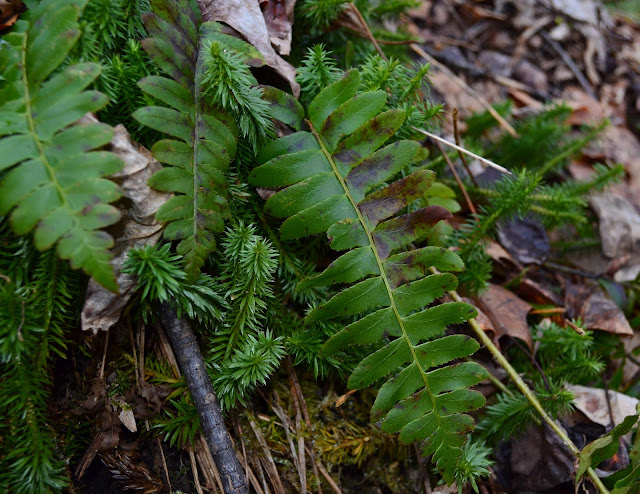One of my favorite plants, the Diphasiastrum digitatum, also known as Running Pine, Southern Running Pine, Groundcedar, Fan Clubmoss, and a whole range of other common names. This species of Diphasiastrum is the most common in North America. Running Pine used to be harvested as Christmas greenery, and due to its slow growth rate, the populations plummeted. They've rebounded, and now they cover the forest floor in some places. I know that AW Marion State Park in Pickaway County and Davis Memorial SNP in Adams County have large populations, as well as the population at Blackhand Gorge.
Here is a small view of the population at Blackhand. They produce spore-bearing strobili that run higher than the main plant, but there are known in this photo. These strobili look like one central stalk that split into 3-6 upright stalks at the end that are brown on the ends.
This pine-tree-like plant is Huperzia lucidula, or more commonly known as Shining Clubmoss. If you noticed, the previous plant, Running Pine, was also a clubmoss. Clubmosses are known as fern allies, and they are similar in structure to the earliest vascular plants too!
Here's another shot showing some of the Shining Clubmoss jutting out of the hillside leading toward the Licking River. Also, as you can see, there's a few fern fronds here. Now, I am not a botanist, but after researching some and talking to a few other people, we've come to the conclusion that this is Dryopteris marginalis, more commonly known as Marginal Wood Fern. Marginal Wood Ferns are evergreen ferns, and they like cool, slightly acidic soil.
Next, onto this interesting clump of moss. This is a Dicranum moss, most likely
Dicranum scoparium because of its curved leaves. Dicranum scoparium is also known as the Broom Moss or Windswept Moss because of its leaves. I personally love mosses and different looking ones like this always raise my curiosity even more.
Definitely not the best photo, it was more of a snapshot (That ended up blown-out), so excuse that. Anyway, as you can see, a covering of green reed-like plants takes center stage. These plants were kind of going everywhere, which leads me to think this was flooded recently, pushing the normally straight-upright plants aside. So what is this plant?
I'm very new to plants (I'm a birder mainly), so if I've made a mistake anywhere, please do not hesitate to correct me. Thanks!




.jpg)

























